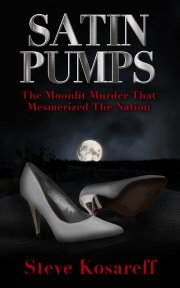Conversation On Shattered Lives Radio Centered Around The Meaning Of “Crazy” And The Vampire of Sacramento

Author Kevin Sullivan
Insanity, Legal Insanity, and the Murderer: It’s a subject that raises its head all the time in the courts, and often, it’s a battle that is pivotal in deciding what happens to those who kill their fellow human beings.

Richard Chase, the “Vampire of Sacramento”
Recently, I was on Shattered Lives Radio with Donna Gore discussing my book, Vampire: The Richard Murders. Our discussion centered around what part, if any, did insanity play in the life of Richard Trenton Chase. Of course, anyone familiar with Richard Chase and his murders will be hard pressed to NOT believe he was insane. Indeed, Chase didn’t just commit murder; he committed murder in the most diabolical of ways. Naturally, our conversation took us into the direction of what constitutes insanity vs. legal insanity.
A native of Sacramento, California, Chase grew up appearing to be a relatively normal person. But not everything was right within his mind, and as he approached adulthood, oddities in his personality started to manifest. It also didn’t help matters that Chase began using hallucinogenic drugs in his late teens, which can, over time, alter a person’s chemical balance within the brain. And for some who go down that road, it culminates in schizophrenia and psychotic episodes.

VAMPIRE: The Richard Chase Murders By Kevin Sullivan
I know something about this from personal experience with my brother, who was diagnosed as a paranoid schizophrenic after years of using the drug LSD, beginning in 1969. Not only did he “lose” his mind forever, but he spent the remainder of his life moving about in a medicated, zombie-like existence.
Now, here is the crux of the matter concerning whatever one might call insanity and legal insanity: Anyone viewing or interacting with someone like Richard Chase would declare him to be insane. And to a point, they’d be correct. But when it comes to a “crazy” person committing murder, one must use the old adage and say, not so fast! To reach the place where a murderer can receive a diagnosis of legal insanity will depend upon the actions of the killer prior to, during, and after the murders.
For example, many years ago in Louisville, Kentucky, in a quiet, low crime neighborhood, a man was seen dragging what appeared to be mannequins to the end of his driveway; obviously intended for pick up by the trash collector. Several neighbors who’d witnessed this, believed the crumpled forms on the ground were in fact mannequins, but when a police officer rolled up to the scene, he knew immediately what had transpired. The man, having killed his mother and brother a short time earlier, was later deemed to be insane at the time of the murders, and this is why he did not attempt to conceal his actions. His insanity was on full display during his interview with detectives. Now on to Richard Chase.
Even before Chase began killing, he exhibited signs of mental illness so striking, that even an untrained person would likely call him crazy. Here are a few things Chase believed about himself, and in some cases, attempted to correct about himself: He believed his blood was turning to powder; he believed his pulmonary artery had been stolen; he believed standing on his head would help his condition; and at times, he’d take the extra step of placing orange slices in a towel and wrap the towel around his head. Richard Chase very much believed he needed to do these things to remain alive. Where Chase differs from the killer described above is that he possessed enough reality to conceal his crimes, fully understanding that murder is against the norms of society. In other words, Chase worked to avoid detection, and despite whatever mental illnesses were present within him, he would be declared mentally ill but legally sane.
Other killers, just as “evil” as Chase (Ted Bundy, for example), would laugh at Chase and consider him stark raving mad. Although both individuals were homicidal psychopaths, who loved necrophilia and thought nothing of mutilating the female corpse (somewhat differently and for different reasons), after this, almost all similarity ends. Richard Chase was delusional, Ted Bundy was not. Chase was often dirty and his clothes were unkempt (during one trip to the emergency room, he was described by the admitting physician as “foul smelling”). Bundy, on the other hand, was always clean and well dressed, articulate, and never showed the slightest sign of mental aberration. Richard chase, however, showed little else. In the end, both men were deemed sane and would stand trial, and both were convicted.
Insanity, defined in legal terms, isn’t always what we think it is.
Kevin Sullivan is the author of the WildBlue Press release, Vampire: The Richard Chase Murders and The Bundy Murders: A Comprehensive History, published by McFarland & Company.




 Join our email list
Join our email list
Is there any documentation that Chase experienced purplish or red urine? Maybe mentioned peeing blood? I have a condition called porphyria, also know as the vampire disease. The experts say that it doesn’t cause a blood and raw meat craving, and I know they’re wrong. I know others with this disease who have the same cravings I do. I feel a kinship with Richard Chase, although I’m too kind-hearted to kill anything- I have trouble swatting flies. But I feel like I understand his bizarre “needs”. I can’t help feeling like he might have had a case of undiagnosed porphyria, which went out of control. If they had diagnosed and treated him before he started killing, maybe all those lives, including his own might have been saved. He really was a handsome man.
Richard Chase was deeply mentally ill, and he was never diagnosed with having that condition. That condition can produce a host of symptoms for those suffering with the disease, but it, according to all available medical data, does not include one that produces a blood or raw meat craving. The only thing one could point to that’s similar to the fictional Dracula, is sensitivity to light. That said, there are numerous medical conditions that cause a sensitivity to light, including those suffering with migraine headaches. Although you may be familiar with this information, here’s a link from the Mayo Clinic…
https://www.mayoclinic.org/diseases-conditions/porphyria/symptoms-causes/syc-20356066